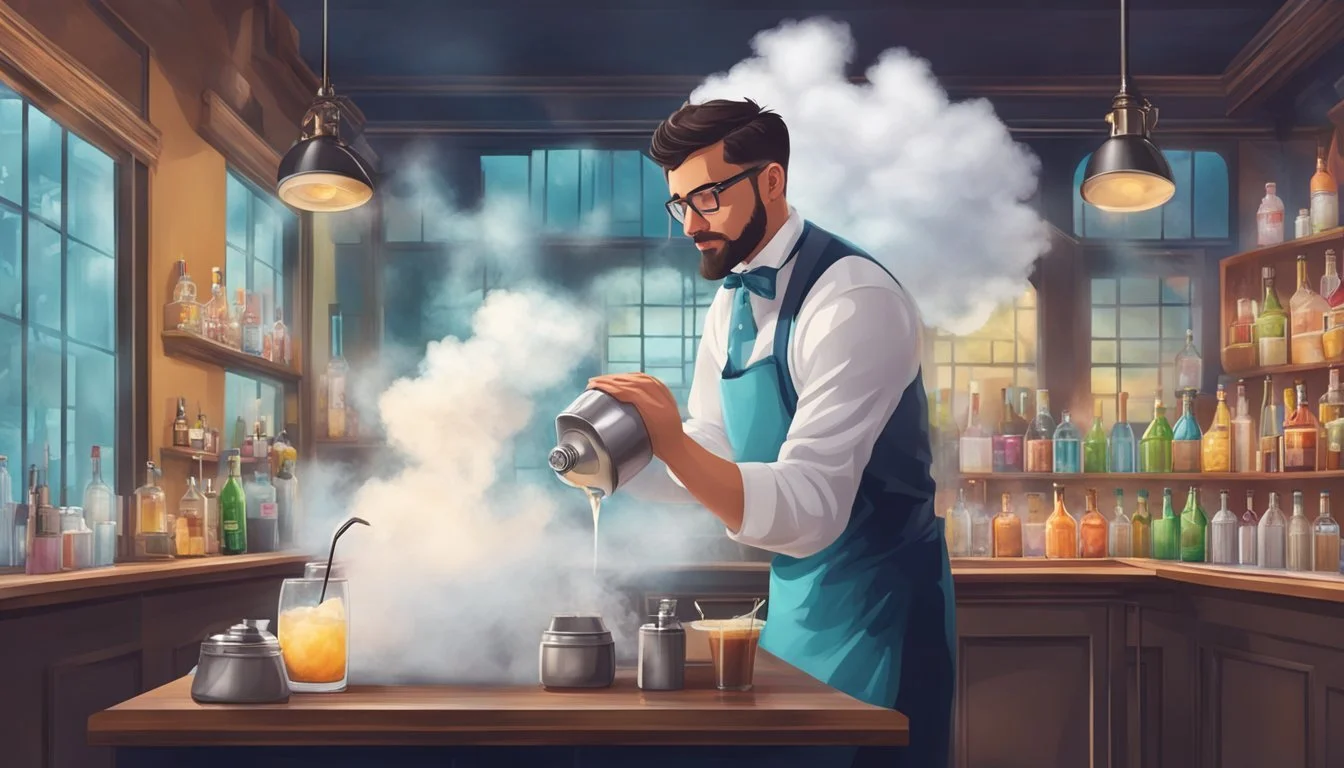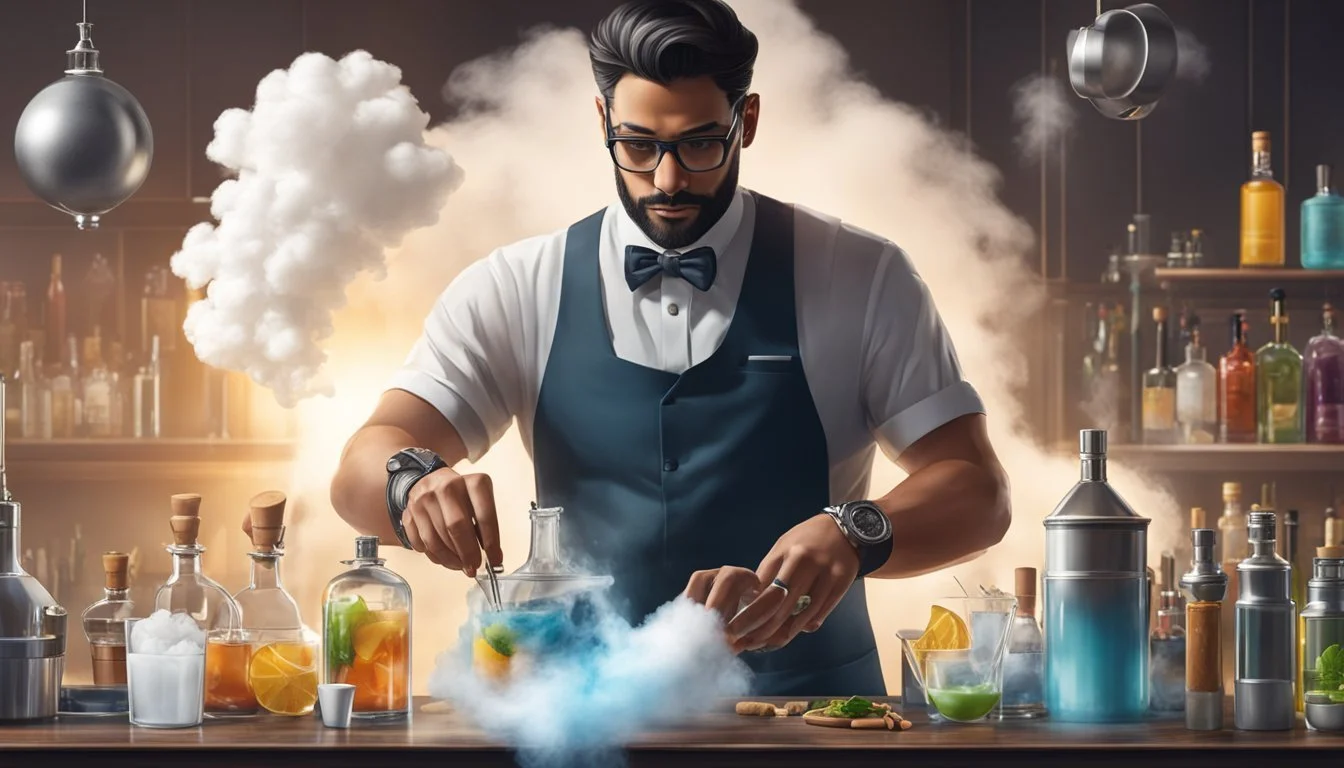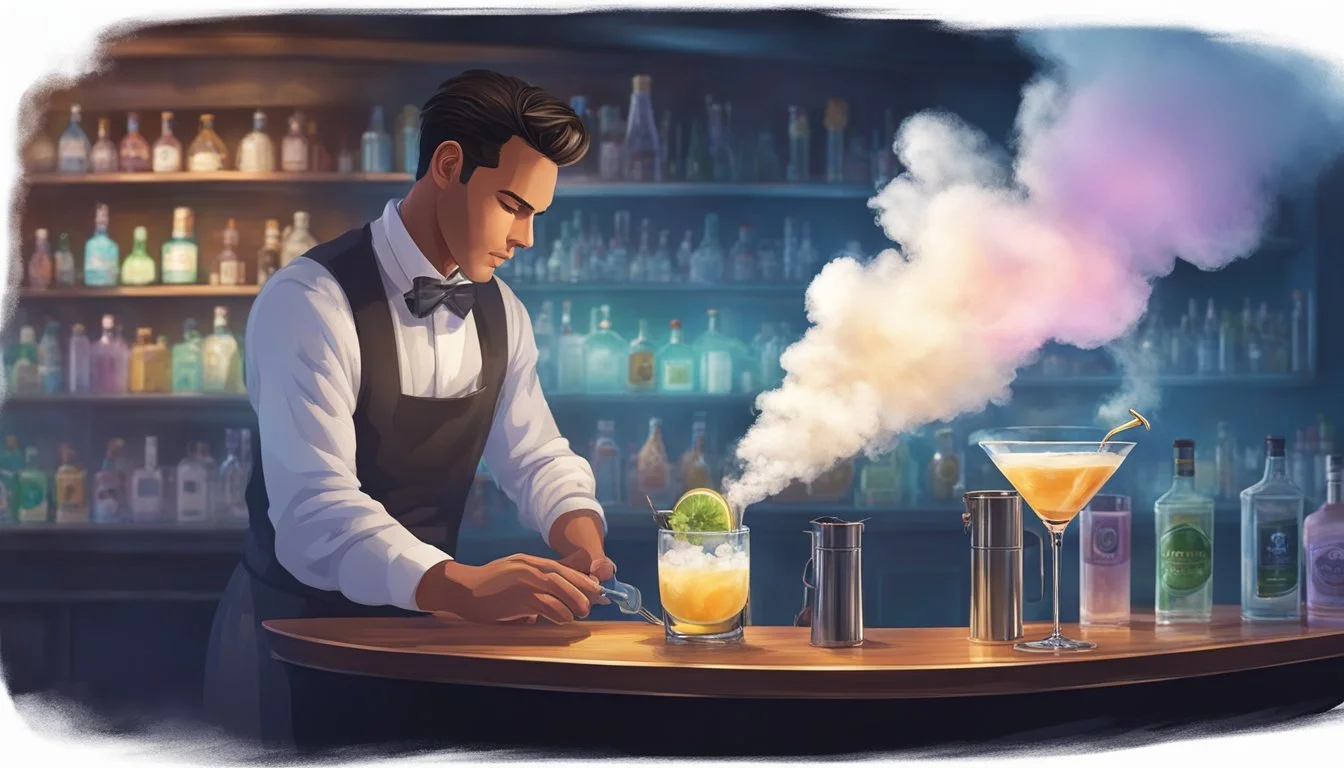Texas Bartenders' Tips for Safe and Spectacular Liquid Nitrogen Cocktails
In the ever-evolving world of mixology, Texas bartenders are pushing the envelope with innovative techniques that transform the cocktail experience. One such avant-garde method is the use of liquid nitrogen, a substance that has given rise to a new breed of icy concoctions. These skillful professionals are leveraging the unique properties of liquid nitrogen to instantly chill drinks, create sensational presentations, and add a tactile sensation that is as intriguing as it is refreshing.
Liquid nitrogen, with a temperature registering at a frigid -320 degrees Fahrenheit, offers mixologists the ability to instantly freeze ingredients, resulting in a smoother and creamier texture in cocktails. However, when working with this cryogenic liquid, safety is paramount. Texas bartenders emphasize the importance of proper handling and equipment, such as protective gloves and Dewar flasks, to ensure an exhilarating, yet secure, cocktail crafting session.
The introduction of liquid nitrogen in cocktails isn't just about the spectacle; it significantly alters the drinking experience. From the visually appealing fog that wafts from the glass to the enhanced mouthfeel of a perfectly chilled beverage, Texas mixologists are demonstrating that incorporating science into their art not only delights the senses but also opens up new dimensions of flavor. As such, an increasing number of establishments across the state are adopting this technique to captivate their patrons, one frosty glass at a time.
The Art of Mixology
This section explores the pursuit of cocktail excellence through traditional methods and the incorporation of avant-garde techniques such as molecular gastronomy. The reader will gain insight into foundational skills and innovative approaches, particularly the use of liquid nitrogen in mixology.
Understanding the Basics
To excel in mixology, a bartender must first understand the fundamental elements of cocktail-making. This includes knowledge of spirits such as gin and vodka, and their taste profiles. Developing a strong foundation in classic flavor combinations is crucial. Experimentation with different ingredients and proportions leads to a mastery over the balance of flavors that characterize an outstanding cocktail.
Spirits: Begin with familiarization of various types of spirits and their distinct flavors.
Techniques: Practice essential bartending skills like muddling, shaking, and stirring.
Advanced Cocktail-Making Techniques
Once the basics are mastered, a mixologist can explore advanced techniques to add novelty and complexity to their creations. Refinement of skills allows bartenders to craft drinks that surprise and delight with their texture and presentation. Infusion, layering, and carbonation are sophisticated methods that offer a sensory experience beyond the traditional cocktail.
Infusion: Utilize fruits, herbs, and spices to infuse spirits for a unique flavor profile.
Carbonation: Incorporate effervescence to refresh and lighten beverages.
Molecular Mixology and Liquid Nitrogen
Molecular mixology takes cocktail creation to the next level, merging science and art. Pioneers like Dave Arnold have popularized this movement, which draws from molecular gastronomy to evolve the cocktail experience. Utilizing liquid nitrogen, mixologists can rapidly chill ingredients, create frozen garnishes, or even produce a smoky effect, enhancing the drink's novelty and aesthetic appeal.
Liquid Nitrogen Techniques:
Chilling: Rapidly cool glasses or ingredients.
Garnishes: Create frozen details for visual and textural contrast.
The Evolution of Craft Cocktails
The craft cocktail scene has evolved significantly, as bartenders build upon traditional techniques and incorporate experimentation with new methods and ingredients. Attention to detail and a dedication to the craft distinguish these artisans from their predecessors. The modern cocktail landscape celebrates the rich history of mixology while boldly venturing into uncharted territories of flavor and presentation.
Historical Techniques: Revisit and refine time-honored methods.
Modern Twists: Push the boundaries with innovative approaches and technologies.
Safety First
When Texas bartenders work with liquid nitrogen, safety is paramount. They acknowledge the substance's ability to instantly freeze and the potential dangers if handled improperly. Protecting themselves and their customers is their top priority.
Handling Liquid Nitrogen Properly
Personal Protective Equipment (PPE):
Goggles: To shield eyes from splashes.
Safety Gloves: Insulated gloves are essential to prevent skin burns.
Procedures:
Storage: Liquid nitrogen should be stored in well-ventilated areas away from customer access.
Transfer: Use only designated dewar flasks for transporting to minimize the risk of spills.
Temperature Consideration:
Due to its extremely low temperature, liquid nitrogen can cause severe frostbite upon contact with skin or eyes.
Knowledge and Training Resources
Organizations Providing Training:
Diageo Bar Academy: Offers detailed courses on handling various bar-related chemicals and substances safely.
British Compressed Gases Association (BCGA): Provides guidance on gases in hospitality, including liquid nitrogen.
Regulatory Information:
Food Standards Agency: They offer guidelines on the safe use of liquid nitrogen in drinks and foods.
Access to Information:
It is crucial for staff to be trained and informed about the current safety considerations related to the use of liquid nitrogen. Training resources are readily available and should be regularly consulted to ensure compliance with safety standards.
Tools of the Trade
When crafting cocktails with liquid nitrogen, bartenders in Texas rely on specialized equipment to ensure safety and precision. The right tools not only make the process efficient but are crucial for achieving the desired dramatic effect and texture in the drink.
Essential Equipment for Nitrogen Cocktails
Nitrogen Dispenser: A key tool for bartenders, this dispenser allows for controlled release of liquid nitrogen into the cocktail, essential for creating that signature foggy effect and rapid cooling.
Shaker: Essential for mixing ingredients before the addition of liquid nitrogen, ensuring even flavor distribution. For nitrogen cocktails, a well-insulated shaker is recommended to handle the extreme cold.
Strainer: After shaking, a Hawthorne or fine mesh strainer is used to separate unwanted solid ingredients from the drink, providing a smoother cocktail experience.
Dewar Flasks: These specialized containers are designed for safe handling and storage of liquid nitrogen. They have vacuum insulation to maintain the extremely low temperatures required.
Protective Gear: Safety is paramount. Bartenders must use cryogenic gloves, face shields, and protective aprons when handling liquid nitrogen to prevent burns.
Choosing the Right Glassware
Glasses: The choice of glass matters greatly and should take into account the dramatic presentation of nitrogen cocktails. Clear glasses are typically used for their visual appeal. However, the glass should be tempered or borosilicate to withstand the rapid temperature change without shattering.
Serving Temperature: The glassware must be pre-chilled to minimize the temperature difference when the nitrogen cocktail is poured, which can also help to reduce the glass breaking risk.
Creating the Perfect Chill
Crafting cocktails with liquid nitrogen is an art that hinges on precision, especially in temperature control to achieve that perfect chill and mesmerizing smoky effect.
Temperature Control and Texture
When bartenders incorporate liquid nitrogen into cocktail making, they meticulously manage temperature to attain optimal chill without completely freezing the drink. The target temperature range is just below freezing, which results in a velvety mouthfeel without solidifying the beverage. This precise chilling enhances the drink's texture and carbonation, leading to a more pleasurable experience.
Goal Temperature Range: Just below 0°C.
Outcome: Enhanced texture, preserved carbonation.
Achieving the Smoky Effect
The smoky effect in cocktails is not just visual flair but also an interactive element that captivates the senses. Texas bartenders use liquid nitrogen to create rolling mists and cascading bubbles by gently pouring it over the cocktail, which instantly vaporizes due to its extremely low temperature. This dramatic presentation should be done safely to avoid contact with skin and surfaces that aren't designed to withstand extreme cold.
Steps for Safe Pouring:
Always wear protective gear.
Pour liquid nitrogen slowly and deliberately.
Ensure the area is well-ventilated.
This careful handling results in the iconic smoky effect, transforming a regular cocktail into an unforgettable, multisensory experience.
The Science of Flavor Enhancement
Mastering the craft of cocktail creation revolves significantly around the enhancement of flavors to delight the palate. Texas bartenders emphasize the thoughtful balance of ingredients and the innovative use of liquid nitrogen to elevate the sensory experience of a cocktail.
Balancing Ingredients for Maximum Flavor
A bartender's approach to flavor enhancement begins with balancing the basic components of a cocktail: sweetness from simple syrup or sugar, acidity from lime juice or other citrus, and the distinct profile of the alcohol base. Cream and egg whites are often added to introduce a rich texture and smoothness. The objective is to achieve a harmony that complements the individual qualities of each ingredient.
Sweetness: Typically derived from simple syrup or sugar, it counterbalances the potency of alcohol.
Acidity: Found in citrus elements such as lime juice, it adds a crispness that can enhance a drink's refreshment factor.
Alcohol: The spirit base provides the backbone of the cocktail and carries the core flavors.
By precisely measuring and tasting, bartenders ensure that no single component overwhelms the others, leading to a well-rounded flavor profile that is both complex and pleasing.
The Role of Liquid Nitrogen in Developing Flavors
Liquid nitrogen, a tool in the domain of molecular mixology, offers bartenders a means to rapidly chill ingredients and concoctions, which can influence both flavor and aroma. When used to freeze ingredients or the entire cocktail, liquid nitrogen intensifies flavors by altering the temperature and texture without diluting the mixture as ice would.
Texture Alteration: Instant freezing can create a smooth, sorbet-like consistency, adding a new dimension to the cocktail.
Aroma Enhancement: Chilling with liquid nitrogen can subdue overpowering alcohol vapors, allowing subtler flavors and aromas to emerge.
It's crucial for bartenders to use liquid nitrogen with care to avoid compromising the integrity of delicate ingredients like juice or tea, and to always ensure safe consumption. The use of this cryogenic substance not only intrigues patrons with a visible spectacle but also serves a scientific purpose in the development of a superior flavor experience.
The Art of Presentation
When crafting cocktails with liquid nitrogen, presentation is paramount. It's not only about the visual spectacle but also the enhancement of the drinking experience through meticulous attention to detail.
Visual Appeal and Aromatics
The presentation of a liquid nitrogen cocktail is a multisensory experience. Colorless and odorless, liquid nitrogen creates a mesmerizing display of bubbles and vapor that captivates onlookers. To maximize visual appeal, bartenders often use transparent glasses to showcase the cloud-like effect of the evaporating nitrogen. Aromatics play a critical role as well; fresh herbs, spices, or citrus peels can be used in conjunction with muddling to release fragrant oils that complement the cocktail's flavor profile.
Glass Choice: Choose clear, high-quality glassware.
Aromatic Techniques:
Muddling: Releases essential oils for a fragrant bouquet.
Garnish: Elegant placement of herbs or citrus can enhance aromas.
Creating Signature Liquid Nitrogen Cocktails
In the realm of nitrogen craft cocktails, the signature Texas approach is all about embracing boldness while ensuring safety and quality. The cocktail shaker becomes a stage for the alchemy of mixology; bartenders must stir or shake ingredients meticulously before adding the liquid nitrogen to avoid over-freezing and to evenly cool the mixture. The result is a signature liquid nitrogen cocktail that delights with its cold temperature and surprising texture, all while evaporating quickly enough to allow safe consumption.
Crafting Steps:
Combine ingredients in a cocktail shaker; stir or shake as required.
Carefully pour liquid nitrogen just before serving to create the desired effect.
In crafting these unique drinks, one must always prioritize safety, making sure the liquid nitrogen has completely evaporated before serving, ensuring an unforgettable and secure drinking experience.
Risks and Responsibilities
Crafting cocktails with liquid nitrogen can offer an impressive visual and sensory experience. However, it is crucial for bartenders in Texas to understand the potential dangers of this substance and to educate their staff and customers on its safe handling.
Understanding the Potential Dangers of Liquid Nitrogen
Liquid nitrogen is a cryogenic liquid that can be extremely hazardous if not used correctly. Its extremely low temperature can cause severe frostbite upon contact with skin or internal tissue if ingested improperly. There have been instances of perforated stomachs due to the consumption of liquid nitrogen before it has fully vaporized.
Key Safety Measures:
Never ingest liquid nitrogen directly.
Ensure liquid nitrogen has fully dissipated before serving a cocktail.
Use proper protective equipment, such as gloves and eye protection.
Store and handle containers with care to prevent accidental spillage.
Educating Staff and Customers
Knowledge and education are vital components of safely incorporating liquid nitrogen into a bar's offerings.
For staff, they must be:
Thoroughly trained in the handling and risks of liquid nitrogen.
Shown how to communicate with customers about waiting for the nitrogen to evaporate before consumption.
Aware of the signs of frostbite and cold burns and first aid procedures.
To inform customers:
Provide clear verbal instructions and display written warnings where liquid nitrogen drinks are served.
Highlight the importance of not consuming drinks immediately after they're made, to avoid internal damage.
Designate a knowledgeable staff member to oversee the preparation and service of these specialty cocktails.
By adhering to strict safety guidelines and maintaining a knowledgeable front, bartenders can enhance their customers' experiences while mitigating the inherent risks presented by liquid nitrogen.
Recipe Inspiration
When it comes to crafting cocktails with a touch of avant-garde, Texas bartenders incorporate liquid nitrogen to elevate classic drinks while also conceiving new innovative mixtures.
Classic Cocktails with a Liquid Nitrogen Twist
Cosmopolitans and martinis gain a dramatic makeover when liquid nitrogen is used. Bartenders might take a Cosmopolitan, typically composed of vodka, triple sec, cranberry juice, and freshly squeezed lime juice, and add a liquid nitrogen chill to create a foggy, theatrical presentation without altering the beloved flavor. Similarly, Texas mixologists could serve a Chocolate Martini enveloped in a cloud of mist, combining chocolate liqueur and vanilla vodka chilled to perfection with liquid nitrogen.
For those who enjoy whiskey-based classics like Manhattans or Old Fashioneds, a hint of frost from liquid nitrogen can enliven these cocktails. The typically warm notes of the whiskey contrast enthrallingly against the icy temperature, showcasing the skill of the bartender and providing patrons with an unexpected sensory experience.
Innovative Cocktails for the Curious
Texas bartenders don't shy away from innovation, especially when it involves tequila and showmanship. Patrons at bars may encounter a tequila cocktail that morphs before their eyes as the bartender skillfully pours liquid nitrogen into the shaker. The result is a super-chilled, smooth drink that's not just flavorful but also visually arresting.
One could witness a Nitro Mojito, where mint, lime juice, light rum, and simple syrup are muddled, shaken with saline and ice, and then finely strained over crushed ice, with liquid nitrogen adding a frosty buzz to this Cuban classic. Texas mixologists are adept at turning the bar into a stage, and these performances embody their creative spirits and command over their craft.
Contemporary Mixology in Texas
Texas mixologists are embracing innovative techniques and local flavors to redefine the cocktail experience. Statewide, bars are not only places for social gatherings but also hubs of culinary experimentation.
Trends in Texas Cocktail Bars
Liquid Nitrogen Cocktails: A stand-out trend in Texas cocktail bars is the use of liquid nitrogen. This technique allows bartenders to rapidly chill glasses, create frozen garnishes, and add a dramatic fog effect to their drinks. Bar-goers are often fascinated by the theatrical presentation of cocktails enhanced with liquid nitrogen.
Craft Cocktail Movement: There is a significant push towards contemporary cocktails that utilize artisanal spirits and ingredients. Texas bars are featuring a variety of unique homegrown spirits like local gin and vodka, tailored with fresh juices and cream to create cocktails with a Texan twist. Science and artistry collide as mixologists experiment with these components to derive new flavors and presentations.
Showcasing Local Texan Ingredients
Local Spirits: Many Texas bars prioritize the usage of locally-produced spirits, which not only supports the regional economy but also provides customers with a taste of the true Texas spirit.
Gin: Distilled with Texan juniper and other native botanicals, it imparts a regional character to gin-based cocktails.
Vodka: Crafted using local grains, this lends a smooth and distinct base to vodka-centric concoctions.
Flavors of Texas: Bar menus often feature cocktails that include ingredients emblematic of Texas's diverse agricultural offerings.
Citrus fruits like grapefruits are used to add fresh, zesty flavors.
Herbs and vegetables from local farms are incorporated to create herbal and earthy undertones.
Special ingredients like local honey and pecans are employed for their natural sweetness and nuttiness, respectively.
Bartenders in Texas have become ambassadors of their state's resources, fusing them into their craft and presenting cocktails that reflect Texas's rich flavor profile and innovative spirit.
Closing Thoughts
In the realm of mixology, bartenders across Texas have elevated the art of cocktail making by incorporating the intriguing science of liquid nitrogen. They finesse the drinking experience, bringing together robust science and innovative bartending techniques. Liquid nitrogen, a component that freezes swiftly and generates a smoky visual, must be handled with expertise and care.
Safety is paramount. Bartenders are trained to use liquid nitrogen responsibly, ensuring that it fully evaporates before consumption. Technique also plays a crucial role—the correct application of liquid nitrogen helps to create tantalizing textures and temperatures, offering a unique sensory delight.
List of key points Texas bartenders consider when using liquid nitrogen:
Temperature Control: To achieve the desired creamy texture in cocktails.
Visual Appeal: The smoky effect adds to the presentation.
Flavor Enhancement: Chilling with nitrogen can refine the drink's flavor profile.
With a deep understanding of both the science and craft, bartenders can safely push the boundaries to offer patrons an unparalleled drinking experience. They are not just serving drinks; they are providing an adventure in a glass—a testament to their innovation in the expansive and ever-evolving landscape of Texas mixology.








